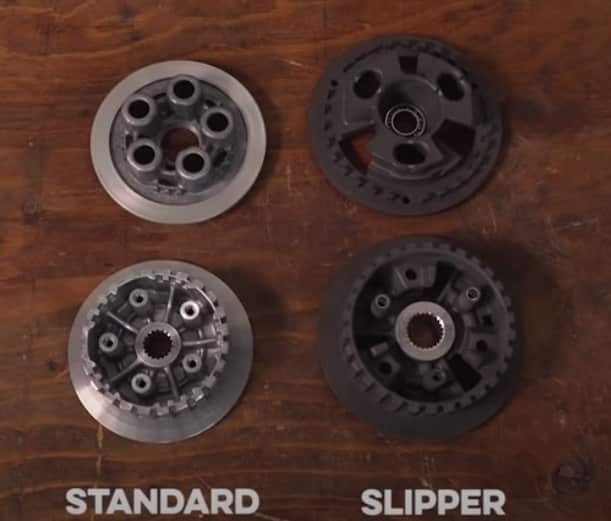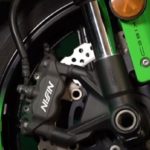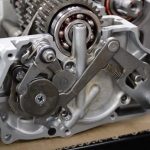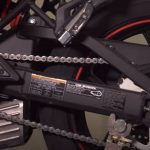Twenty years ago, slipper clutches were reserved for race bikes or bikes that have been modified for track riding.
On the track, a slipper clutch is helpful because downshifts are usually performed while you’re on the front brake. Not only is there a lot of engine braking, taxing the rear tire and the suspension, but there’s very little static load pushing the tire into the pavement.
Questions Answered In This Article
- Which Motorcycles Have a Slipper Clutch?
- What Does A Slipper Clutch Do?
- Do You Need To Rev Match With a Slipper Clutch?
- What Kind Of Oil To Use In A Slipper Clutch?
- Slipper Clutch vs. Quickshifter
Which Motorcycles Have a Slipper Clutch?
These days, you can find slipper clutches on all kinds of bikes. From performance machines like the Ducati Panigale, all the way down to beginner bikes like the Ninja 300. Slipper clutches even come on certain sports tours and cruisers.
What Does A Slipper Clutch Do?
The whole idea behind a slipper clutch is it helps prevent rear-wheel chatter and engine over-rev during hard engine braking caused by aggressive downshifts.
Rear-wheel chatter, a skid, or a full-on crash can be the result. Obviously, not a good thing.
On the street, a slipper clutch might come into play if you downshift accidentally, if you have a sloppy downshift in the wet, or on a slippery surface, or if you downshift one more time than you expected.
Most people aren’t going to make that kind of mistake, but the clutch could save your bacon if you do a slipper.
So keeping the bike’s backend calm during engine braking is why a slipper clutch is beneficial.
What is the difference between a normal clutch and a slipper clutch?
This is the pressure plate and inner hub out of a standard non-slipper clutch, and these are the parts out of a slipper.

The most common type of slipper clutch has ramps built into the inner hub and the pressure plate, and when the rear wheel begins driving the engine under deceleration, the ramps are forced together, and they ride up each other.
It pushes the pressure plate away from the clutch pack, which reduces clamping force in the clutch plates and allows them to slip past each other.
Do You Need To Rev Match With a Slipper Clutch?
It’s The same action you’d get if you applied a little bit of pressure to the clutch lever, but with a slipper clutch, it happens automatically. So, no rev-matching or clutch finesse is required.
Recent evolution of the slipper clutch is the slip and grip clutch. In addition to ramps that push the pressure plate out during hard engine braking, some ramps force the plate in during acceleration.
This puts additional pressure on the clutch plates to help prevent slippage.
Since the grip ramps are forcing the clutch pack together, fewer or lighter clutch springs can be used, which means you get a nice light lever pull.
What Kind Of Oil To Use In A Slipper Clutch
If your bike has a slipper clutch, you might be wondering what kind of oil you need to use.
As I pointed out in the how a clutch works video, you just want to make sure that oil says MA or MA2 on the back. That means it was designed for use in a motorcycle clutch.
Also, steer clear of automotive oils that say energy-conserving because they’re going to cause your clutch to slip and not in a good way.
Slipper Clutch vs. Quickshifter
Imagine seamless upshifts without using the clutch or even rolling off the throttle. Sounds fun, right? Well, that’s exactly what quick shifters allow you to do, and we’re going to explain how they work.
We’ve already covered clutchless shifting and how motorcycle transmissions work.
Like radio brake calipers, inverted Forks, and single-sided swing arms, this technology was born at the track from a desire for faster lap times.
But this tech has trickled down to the street, and I love that we see it on so many different models because quick shifters are so much fun to use.
They allow you to do upshift without pulling in the clutch or even rolling off the gas.
You just get to keep the throttle pinned, you tow the shifter, and the transmission shifts into the next gear seamlessly.
It is completely unnecessary for the street, but man, is it fun to use and totally addicting.
Normally with shift gears, you would roll out of the throttle slightly and pull in the clutch because the gears down the transmission need to be unloaded for the cogs to shift over into the next position.
With a quick shifter, you don’t have to do any of that; here’s how it works.
A sensor is integrated into the shift Linkage that detects when the shifter moves and queues the bike’s ECU to interrupt ignition spark momentarily.
So right as you’re towing the shifter, there’s a millisecond long pause in power that unloads the gears just long enough for them to slip into the next position. No clutch or throttle-blip required airing.
Airing the throttle to upshift may only take a split second, but those half seconds add up when you’re racing.
With a quick shifter, shifts happen so fast the drive is essentially uninterrupted.
That means you can grab a gear between corners, or you can even grab a gear while banked over, leaving a turn.
Quick shifters also free up attention since shifting goes from an action that requires two synchronized motions to one independent movement.
None of that stuff really matters on the street, but quick shifters are still a fun, convenient feature in an easy way to make any motorcycle feel sporty.
Manufacturers are throwing quick shifters on all kinds of bikes, from the new Vitpilen 701 to touring bikes like BMW’s K1600.
If your motorcycle doesn’t come with a quick shifter, there are lots of aftermarket options.
Pizazz makes them for pretty much every bike out there, and you can get it as a standalone quick shifter kit or as part of a comprehensive fuel controller.
Some people say that quick shifters are for lazy riders. In my opinion, if you don’t like quick shifters, it’s only because you haven’t tried one yet.
Honestly, there are a lot of fun, even if you don’t consider yourself an aggressive rider.
The only real drawback to regularly using a quick shifter is that your throttle and clutch finesse skills might get rusty, and that’s a legitimate concern. Other than that, some bikes just don’t like quick-shifting, especially at lower rpm.
Luckily, most aftermarket kits allow you to program the ignition cut time as well as the sensitivity of the shift sensor, so you can fine-tune the functionality for the way you ride.
I suppose you are wondering about auto blip downshifting m that is the cutting edge of electronically enhanced gear changes.
Auto blip comes on a few bikes as standard, and there are aftermarket kits.
The motorcycle has to have ridden by wire throttle so the controller can auto blip the throttle plates so the bike can shift into the lower gear.
You have an overview of the functionality and benefits of the modern slipper clutch and the difference between a slipper clutch and a quick shifter.
Related Articles
- 4 Things To Wear To Stay Warm On Your Motorcycle In Winter
 Most of us here ride to work every day all year round, and we have lots of personal experience when it comes to taming the elements.
Most of us here ride to work every day all year round, and we have lots of personal experience when it comes to taming the elements. - How To Clean Your Motorcycle In 5 Easy Steps
 We all love a clean and shiny motorcycle but knowing which cleaning products to buy can sometimes be a little daunting, and so too can be the method to clean your motorcycle.
We all love a clean and shiny motorcycle but knowing which cleaning products to buy can sometimes be a little daunting, and so too can be the method to clean your motorcycle. - How Does A Manual Transmission Work On A Motorcycle
 For most people, their motorcycle transmission is one of the most mysterious parts of their bike. How does it work, and why do we shift down into first, but then
For most people, their motorcycle transmission is one of the most mysterious parts of their bike. How does it work, and why do we shift down into first, but then - How Sprockets Affect Speed on Motorcycles And Why
 It doesn’t matter if you’re a racer; if you’re just into trails riding your dual-sport, your bike can be geared differently to your performance needs. Not only on a dirt
It doesn’t matter if you’re a racer; if you’re just into trails riding your dual-sport, your bike can be geared differently to your performance needs. Not only on a dirt - 3 Reasons Why Wheelies Are Bad For Your Motorcycle
 Wheelies are super fun, and we all know that wheelies are one of the purest forms of joy known to humanity, but they can be dangerous. Wheelies are bad for
Wheelies are super fun, and we all know that wheelies are one of the purest forms of joy known to humanity, but they can be dangerous. Wheelies are bad for


